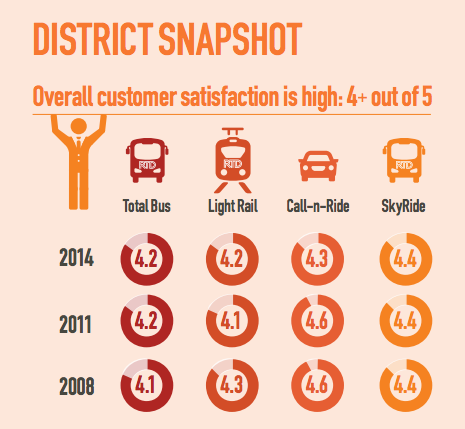Fixing Denver Transit Barely Registers With RTD Board of Directors

The Regional Transportation District’s Board of Directors is more concerned with expansion to the outer suburbs than with providing better transit in Denver itself. At least that’s what we can glean from a conversation board members had last night about RTD’s strategic five-year plan.
Board members critiqued the draft plan for various shortcomings — it’s too detailed, it doesn’t stress low-income subsidies — but never once did anybody ask what RTD plans to do to improve transit service in Denver, the engine of the region’s economy.
The omission was curious because Denver officials are working on an intra-city transit plan that would improve service with higher bus frequencies, bus rapid transit routes, and possibly light rail or streetcar lines in the future. Maybe Denver will buy up service from RTD to pull off some of the improvements, or maybe the city will start its own transit company. That remains to be seen. Regardless, it should be on RTD’s radar.
What was obvious from last night’s discussion was that board members aren’t as worried about the shoddiness of transit service in Denver as they are with suburban and exurban expansion. This despite — or maybe because of — all the money and attention that has already been lavished on FasTracks, the monumental project to build a regional transit network.
FasTracks was and is necessary, but the board is already talking about adding routes beyond the five new lines opening next year. Board member Kent Bagley, for instance, wants RTD to be “a leader on the Front Range.”
“Who knows what this district may be charged with in the future or decide to take on?” Bagley said in a critique of the plan. “So I think it’s really important to look at what’s going on in the Front Range, maybe in the state.” Bagley had just returned from a transit conference in Salt Lake City, where he apparently became enthralled by the idea of connecting the metro area to the ski slopes. Does anyone think that’s a good use of limited resources for an agency that needs to help people get to work and conduct their daily lives?
Here’s what RTD’s draft five-year plan says about “system optimization”:
FasTracks, however, will not meet all the transit demands expected during the longer time horizon of 15 to 25 years. These 2040 transit needs, based on Denver Regional Council of Governments jobs and housing growth projections, must be planned for implementation a decade or more from now. Addressing these needs may require improving the existing system’s capacity. Other needs will likely be met by a thorough exploration of bus rapid transit investments throughout the District, both on arterial streets and on State highways.
The above language wasn’t vague enough for board member Lorraine Anderson, who said, “I think in order to be flexible the strategic plan should not be too detailed.” But that’s the problem: There’s no detailed plan to improve Denver’s transit system, even as demand grows, along with its population.
Blame the structure of RTD. The same governing body responsible for busing people from Five Points to Lowry is responsible for busing people from Boulder to Pine. Board members from every corner of the region represent constituencies with different needs, making RTD’s governing system unwieldy and diffuse.
Regional connections are important, but now that Denver’s growing up, it’s time for a mature approach to its transit issues. The board’s reaction to the strategic plan underlines the need for an approach to transit that devotes sorely-needed attention to the urbanizing, growing city of Denver.


